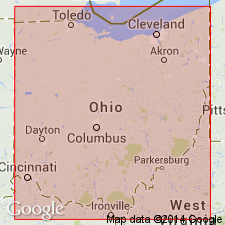
- Usage in publication:
-
- Sunbury black slate
- Modifications:
-
- Named
- Dominant lithology:
-
- Shale
- AAPG geologic province:
-
- Appalachian basin
Summary:
Named Sunbury black slate for Sunbury, Delaware Co., OH. Consists of black bituminous shale, 10-15 ft thick, overlying Sunbury calciferous sandrock, 90-100 ft thick, and underlying Raccoon shales (Cuyahoga formation). Unit is part of Waverly group. Considered of Mississippian age.
Source: GNU records (USGS DDS-6; Reston GNULEX).
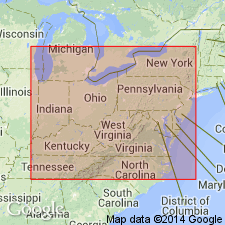
- Usage in publication:
-
- Sunbury Shale*
- Modifications:
-
- Areal extent
- AAPG geologic province:
-
- Appalachian basin
Summary:
Sunbury Shale extended into western VA.
Source: GNU records (USGS DDS-6; Reston GNULEX).
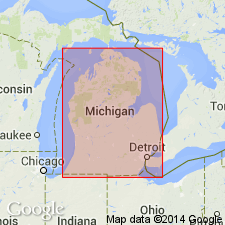
- Usage in publication:
-
- Sunbury Shale
- Modifications:
-
- Overview
- Areal extent
- AAPG geologic province:
-
- Michigan basin
Summary:
The Sunbury Shale is not exposed in MI, but is strictly a subsurface unit. It overlies the Berea and is a black carbonaceous shale similar to the Antrim with which it is vertically contiguous in the central part of the Michigan basin. It is distinguished from the Antrim by its darker color and by the scarcity of algal spores. In the eastern half of the basin the Sunbury is commonly about 6 to 18 m thick. Reaches a maximum thickness of slightly more than 36 m in the northern thumb area. Thins westward. Locally overlies the Ellsworth Shale, but in southwestern MI, the Sunbury grades into the Ellsworth and is absent.
Source: GNU records (USGS DDS-6; Reston GNULEX).
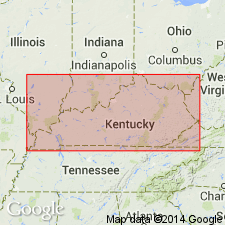
- Usage in publication:
-
- Sunbury Shale Member
- Modifications:
-
- Revised
- AAPG geologic province:
-
- Appalachian basin
Summary:
In this study, the Chattanooga Shale is divided into (ascending) Rhinestreet Shale, Upper Olentangy Shale, Ohio Shale, Bedford Shale, Berea Sandstone, and Sunbury Shale Members. Throughout most of the region, the dominant lithology is black, organic-rich shale (Rhinestreet, Ohio, and Sunbury). The Chattanooga thins westward. Geophysical logs indicate that in the western region, unit consists of only the Sunbury, Berea-Bedford, and Ohio Members, the Rhinestreet and Olentangy having pinched out. Although the Sunbury occurs throughout the study area, in the extreme western part the intervening Berea-Bedford interval pinches out and the Sunbury can only be recognized by its high-radioactivity gamma-ray signature. The Sunbury thickens to the east toward the Hazard strike section, where it again begins to thin near the KY-WV border. According to the author, formal nomenclature presented in this report has been accepted by the Kentucky Stratigraphic Nomenclature Committee. Report includes correlation charts, cross-sections, and measured sections.
Source: GNU records (USGS DDS-6; Reston GNULEX).
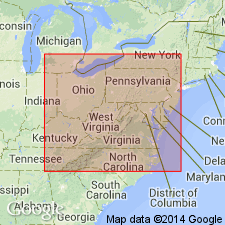
- Usage in publication:
-
- Sunbury Shale*
- Modifications:
-
- Overview
- AAPG geologic province:
-
- Appalachian basin
Summary:
Sunbury Shale is the youngest of the regionally extensive black gas shales. It is typically fissile black shale that weathers into small discoidal sharp-edged chips. Pyrite is common, particularly near the base where it separates a zone of small inarticulate brachiopods and SIPHONODELLA conodont fauna from the underlying Berea. Unit is present only in the western part of the basin. Crops out at many places along the eastern flank of the Cincinnati Arch in OH and northeastern KY and ranges there from 10 to 40 ft thick. Thins to a featheredge toward the east. Overlies the Berea throughout eastern OH, WV, and northern KY, but overlies the Cleveland Member of the Ohio Shale in central KY. Grades laterally into the upper unit of the Gassaway Member of the Chattanooga Shale in south-central KY and is present only as a biostratigraphic zone in the top of the Gassaway in north-central TN.
Source: GNU records (USGS DDS-6; Reston GNULEX).
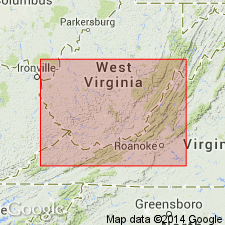
- Usage in publication:
-
- Sunbury Shale Member
- Modifications:
-
- Revised
- AAPG geologic province:
-
- Appalachian basin
Summary:
Cross section between Norton and Asberrys, VA, in the Clinch Mountain outcrop belt shows more detailed divisions of Chattanooga Shale than previously indicated. Base of Chattanooga marked by Belpre Ash. Ascending, members are Rhinestreet Shale, Angola Shale, Java Shale (including the Center Hill Ash), Dunkirk Shale Tongue of Huron Shale Member and remaining upper part of Huron, Three Lick Bed, Cleveland Shale Member, and Sunbury Shale Member. Sunbury Shale Member also assigned to Price or Pocono Formations to the east and north. According to authors, divisions are based on careful outcrop description and outcrop gamma-ray log. Divisions can be traced by borehole gamma-ray logs to their type areas in OH and NY.
Source: GNU records (USGS DDS-6; Reston GNULEX).
For more information, please contact Nancy Stamm, Geologic Names Committee Secretary.
Asterisk (*) indicates published by U.S. Geological Survey authors.
"No current usage" (†) implies that a name has been abandoned or has fallen into disuse. Former usage and, if known, replacement name given in parentheses ( ).
Slash (/) indicates name conflicts with nomenclatural guidelines (CSN, 1933; ACSN, 1961, 1970; NACSN, 1983, 2005, 2021). May be explained within brackets ([ ]).

